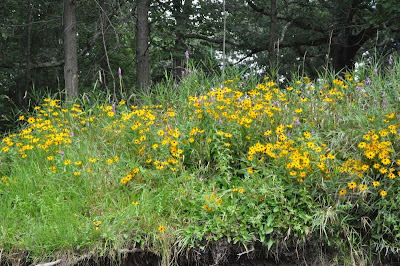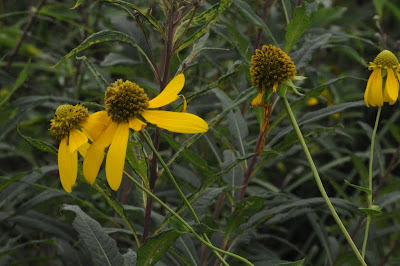For years I have loved the russets, purples and subtle reds that the grasses display, but this is the first time I've had the opportunity to really examine grasses up close (outside the Ice Meadows on the Hudson River).
The colors are astounding. The shapes, the bits and pieces - they delight the eye.
Today I've been examining the photos I recently took of one of our native grasses: big bluestem (Andropogon gerardi). Just what are all those colorful parts...and why aren't the colors consistent from plant to plant? Does it have to do with degree of ripeness?
First up, we have a blurry picture of big bluestem (blurry because, as usual, the wind started to blow once I took out my macro lens - really must build a wind box if I'm going to keep at this). Note the pink feathery bits and the yellow or orange bits.
Here is another image. Pink feathery bits and yellow bits - not an orange bit to be seen anywhere.
And, finally, specimen three. Its feathery bits are a pale yellow, bordering on pale green. The other bits are pink with barely yellow tips - not yellow or orange at all.
What is going on?
First I had to figure out what all these bits are. These are flowers, after all, so the bits must be similar to any other flower: anthers, stamens, stigmas, ovaries, sepals, etc.
It took a while, but I finally tracked down a sketch of the parts of a grass flower. Here's what I found out.
The feathery bits are the stigmas - part of the female reproductive system. They are attached, via a style, to the ovary, which you cannot see in these photos as it is tucked inside. The stigma is the part that "receives the pollen." The feathery nature of the stigma sure makes sense, since grass pollen is blown about by the wind. I love these bits - one doesn't expect to find feathers growing on a plant.
The dangly bits, be they yellow, orange or pink, are the anthers. This is the terminal part of the male reproductive system, and it is here that the pollen is made. The thread-like bit attached to the anther is the filament, and that's what tethers the anther in place.
The long scales are the sepals, which are modified, sterile leaves. Sometimes sepals can be quite colorful and mistaken for flower petals. And as colorful as they might be, these grass sepals will never be mistaken for petals.
If you see what look like long hairs at the tips of the sepals, these are the awns. On some plants the awns act as triggers, which are activated when an insect (or a bumbling naturalist) brushes against them, sometimes (depending on the plant) causing an explosive release of pollen (see this post I wrote about bunchberry).
As for the colors, well, I still don't know. I suspect, though, that they reflect the age of the plant. I know my coloration is certainly changing as I age!




















































